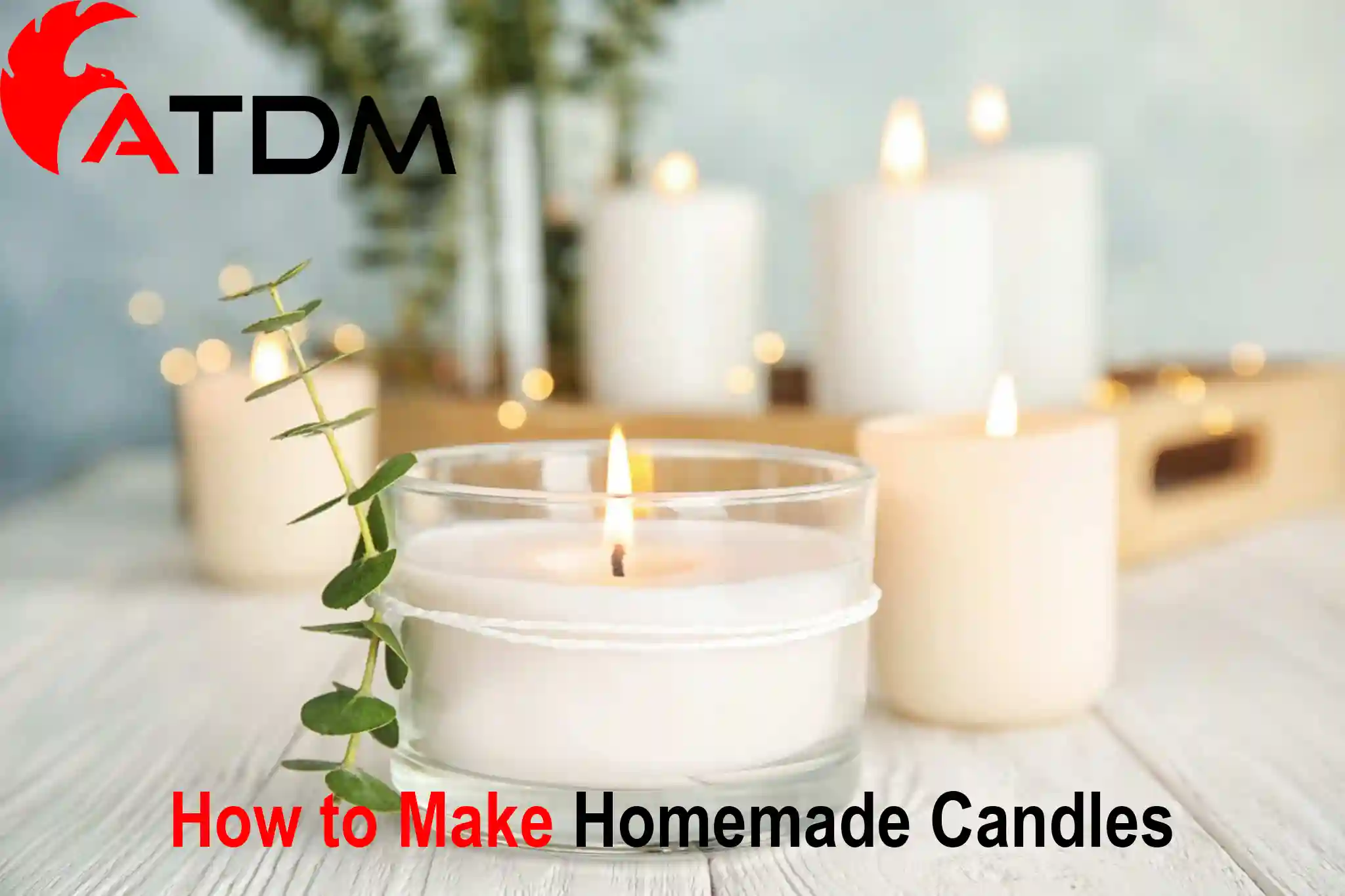
Why Homemade Candles Are So Popular
Making homemade candles isn’t just a fun hobby — it’s also a relaxing and rewarding way to add warmth and personality to your home.
With a few simple materials and a bit of creativity, you can create candles that smell amazing, look beautiful, and even make perfect gifts.
Even better, homemade candles can be made from natural waxes, which are more sustainable and customizable than store-bought ones.
Table of Contents
ToggleLet’s explore how you can make your own candles safely and effectively — even if you’re a total beginner.
What You Need to Make Homemade Candles
Before you start, gather your materials.
Here’s a complete checklist for your first candle-making session:
| Material | Purpose |
|---|---|
| Wax (paraffin, soy, beeswax, or palm wax) | The main ingredient for your candle |
| Wick | Helps the candle burn evenly |
| Container or Mold | Holds the melted wax (e.g., glass jar, tin, or mold) |
| Fragrance Oils or Essential Oils | Adds scent |
| Color Dyes or Natural Pigments | Adds color to your candles |
| Double Boiler or Melting Pot | Used to melt wax safely |
| Thermometer | Measures wax temperature |
| Stirring Stick or Spoon | Mixes wax, scent, and color |
| Scissors | To trim the wick |
Most of these materials are easy to find online or at local craft stores. If you prefer eco-friendly options, choose soy or beeswax for natural, non-toxic results.
Step 1: Choose Your Wax Type
The first and most important step in making homemade candles is choosing your wax type.
Here are some common options:
-
Paraffin Wax: Classic and affordable, melts easily, holds scent well.
-
Soy Wax: Natural, clean-burning, and great for beginners.
-
Beeswax: Long-lasting, natural honey scent, eco-friendly.
-
Palm Wax: Crystallizes beautifully, creating a unique texture.
-
Coconut Wax: Smooth and luxurious with excellent scent throw.
Each wax type affects your candle’s burn time, scent, and finish, so choose based on your goals.
For example, soy and beeswax are best for cleaner air, while paraffin is great for bright colors and strong scents.
Step 2: Prepare Your Workspace
Candle-making involves hot wax, so safety comes first.
Cover your workspace with old newspaper or paper towels, and keep children or pets away while working.
Make sure to have:
-
A heat-resistant surface for pouring wax
-
Tongs or gloves for handling hot equipment
-
A thermometer to monitor melting temperature
Working safely keeps your homemade candle project enjoyable and mess-free.
Step 3: Melt the Wax
Once you’ve chosen your wax, it’s time to melt it down.
-
Fill the bottom pot of a double boiler with water and place your wax in the top pot.
-
Heat gently, stirring occasionally.
-
Use the thermometer to check the temperature.
The ideal melting temperature depends on your wax type:
| Wax Type | Melting Point (°C) | Melting Point (°F) |
|---|---|---|
| Paraffin | 55–65°C | 130–150°F |
| Soy | 50–55°C | 122–131°F |
| Beeswax | 62–67°C | 144–153°F |
| Palm | 60–65°C | 140–149°F |
Tip: Don’t overheat the wax — it can burn and lose its scent quality.
Step 4: Add Color and Fragrance
Now comes the fun part — making your candle unique!
Once your wax is fully melted:
-
Add a few drops of liquid dye or a small piece of wax color block to achieve your desired shade.
-
Stir until the color is even.
-
Remove the wax from heat and let it cool slightly (to around 70°C or 160°F).
-
Then add fragrance oil or essential oil — usually 6–10% of total wax weight.
Stir well to make sure the scent spreads evenly throughout the wax.
You can use scents like:
-
Lavender for relaxation
-
Vanilla for warmth
-
Citrus for energy
-
Cinnamon for coziness
Step 5: Prepare the Wick and Container
While the wax cools slightly, prepare your containers or molds.
-
Secure the wick in the center using a wick holder or clothespin.
-
Make sure it stands straight — this ensures your candle burns evenly.
-
Pre-warm your container (especially glass jars) to prevent cracking when hot wax is poured in.
If you’re using molds, lightly coat them with vegetable oil to help the candle release later.
Step 6: Pour the Wax
Once your wax has cooled to around 60°C (140°F), it’s ready to pour.
Pour slowly and steadily into your prepared container or mold, avoiding air bubbles.
Leave a little space (about 1 cm) at the top.
Then, let your candle cool undisturbed for several hours.
If the surface dips slightly while cooling, reheat a small amount of wax and top it off.
Step 7: Trim and Finish
Once the wax has completely set and hardened:
-
Remove any wick holders.
-
Trim the wick to about 0.5 cm (¼ inch).
You can decorate your candle jar with ribbons, labels, or dried flowers.
This personal touch makes your homemade candles ideal gifts for birthdays, holidays, or cozy home décor.
Safety Tips for Making Homemade Candles
Even though it’s fun and relaxing, candle-making still involves heat and flammable materials.
Keep these safety tips in mind:
-
Never leave melting wax unattended.
-
Always melt wax using a double boiler, not direct heat.
-
Don’t pour hot wax down the drain.
-
Allow candles to cool completely before lighting.
-
Keep open flames away from curtains, papers, or pets.
Following these precautions ensures your homemade candle experience stays safe and enjoyable.
Creative Ideas for Homemade Candles
Once you’ve mastered the basics, try experimenting with styles and techniques:
-
Layered Candles: Pour different colored wax layers for a rainbow effect.
-
Scent Blends: Mix complementary fragrances like vanilla and coffee.
-
Decorative Containers: Use teacups, tins, or coconut shells.
-
Embedded Candles: Add dried flowers or herbs (outside the flame area) for decoration.
Your imagination is the only limit!
Environmental Benefits of Homemade Candles
Making candles at home isn’t just creative — it’s eco-friendly too.
You can choose natural, biodegradable waxes like soy or beeswax and avoid harmful additives often found in mass-produced candles.
Plus, by reusing containers, you cut down on packaging waste and reduce your carbon footprint.
Homemade candles are a small but meaningful step toward a greener lifestyle.
ATDM – Trusted Supplier of Quality Candle Wax
If you want professional results for your homemade candles, start with high-quality wax.
ATDM is a global supplier of refined paraffin, soy, and microcrystalline waxes, all known for their purity, smooth texture, and consistent performance.
With years of expertise in wax refining and petrochemical production, ATDM provides the perfect base material for homemade candles, decorative waxes, and craft projects.
Their commitment to quality, sustainability, and safety ensures your candles burn cleaner, brighter, and longer.
Final Thoughts
Making homemade candles is a craft that blends science, creativity, and relaxation.
It allows you to design beautiful, fragrant pieces that reflect your personal style while adding warmth to your home.
By choosing the right wax, following proper techniques, and using materials from trusted suppliers like ATDM, you can create candles that are safe, sustainable, and stunning.
So, gather your supplies — and let your candle-making journey begin!

